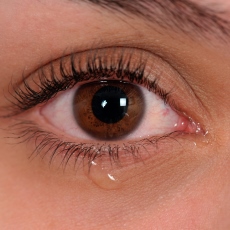 |
| (c) Medlineplus.gov |
This study was published in Ophthalmology, the journal of the American Academy of Ophthalmology.
In this study, investigators enrolled 17 patients infected with COVID-19 at various time points in the disease’s natural history. Sixty-four tear samples were collected with Schirmer’s strips between 3 to 20 days after the onset of COVID-19 symptoms, with the majority (52) of the samples collected between the first and third week. The investigators also took samples from the back of the nose and throat during the same time period. While the patients' tears were clear of virus, their noses and throats were teeming with COVID-19.
Since you’re here...we have a small favor to ask. Retina Global is a nonprofit, and we have to depend on your support to sustain the work we do. Hence the need to ask for your help. Retina Global's work is important, since it not only provides help to disadvantaged people, but also provides resources for developing new treatments that can potentially cure blindness. What we do takes a lot of time, money and hard work. But we do it because we believe we have to help stop someone somewhere from going blind. So make a difference. Click here to donate. Your support is much appreciated. Thank you!
What were the outcomes of this study? Viral culture and real-time PCR assays did not detect SARS-CoV-2—the causative virus for COVD-19—in any of the tear samples, regardless of a patient’s positive nasopharyngeal PCR. Of particular interest was the negative result from a tear sample collected on day 17 from the only patient in the series with conjunctivitis, which developed after admission.
Any limitations? Albeit timely amidst the growing pandemic, these highly preliminary results require validation by forthcoming studies with a much larger number of replicates at each time point in the natural history of COVID-19. The study’s viral detection methods may have also affected its accuracy in light of a different PCR assay and laboratory being used to test the tear samples and nasopharyngeal swabs; omission of conjunctival scrapings from the screening protocol may have also affected accuracy. Finally, the study’s convenience sampling, although employed out of necessity, resulted in the collection of relatively few data from COVID-19 patients during their first week of symptoms and no data from asymptomatic outpatients despite the potential importance of these subpopulations to emerging public health mitigation strategies.
What is the clinical significance? The negative results from both viral culture and PCR testing of tears collected from this small Singaporean cohort of 17 COVID-19 inpatients suggest that the virus may not be readily transmissible from ocular discharge. This is consistent with the current position held by both the World Health Organization and Centers for Disease Control, which describe respiratory droplets and their contact with oral, nasal or ocular mucosa as the primary mode of transmission.
What do we all learn from this study? Despite this reassuring news, it's important for people to understand that guarding your eyes -- as well as your hands and mouth -- can slow the spread of respiratory viruses like the coronavirus. Here's why: When a sick person coughs or talks, virus particles can spray from their mouth or nose into another person's face. You're most likely to inhale these droplets through your mouth or nose, but they can also enter through your eyes. You can also become infected by touching something that has the virus on it -- like a table or doorknob -- and then touching your eyes.
Sources: 1 2 3. If you wish to read an editorial on this study, read "Not time for Tears".
More about Retina Global here. We seek your support. Click here to donate.
No comments:
Post a Comment
Thanks for your comments. We will get back to you shortly if there is a need to respond to it.
- Admin, Retina Global
Read more on Retina Global.